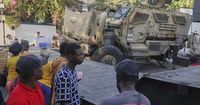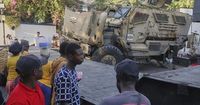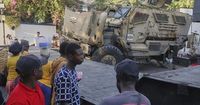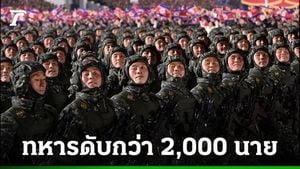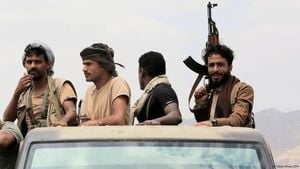On the evening of August 31, 2025, the already tense streets of Port-au-Prince, Haiti, saw tragedy unfold as two armored vehicles collided along the Kenscoff-Pétion-Ville route on the capital’s outskirts. The accident, involving Kenyan police officers serving under a United Nations-backed mission, left two people dead and eight officers injured, casting a somber shadow over an international effort already marked by hardship and danger.
According to the Associated Press, the incident took place during a towing operation gone awry. One armored vehicle, tasked with towing a disabled counterpart, broke down itself—leading to the fatal accident. Mission spokesman Jack Ombaka confirmed the details, stating that among the fatalities were a Kenyan police officer, a member of the U.N.-backed mission fighting to reclaim Haiti’s streets from entrenched gangs, and a civilian bystander. The eight injured Kenyan officers included three in serious condition, who were quickly airlifted to the neighboring Dominican Republic for urgent medical care.
This is not the first time the U.N.-backed mission has faced loss. As Ombaka pointed out, this latest tragedy brings the number of Kenyan police officers killed in Haiti since the mission’s inception over a year ago to three. One officer previously lost his life in a gang attack, while another remains missing and is presumed dead. The mission’s ongoing dangers have become all too real for the officers and their families back home, as well as for Haitians who have witnessed the violence and instability that prompted international intervention in the first place.
The accident occurred on a route that has become all too familiar to those following Haiti’s recent struggles. The Kenscoff-Pétion-Ville corridor, running through the hilly outskirts of Port-au-Prince, is a lifeline for the city but also an area fraught with risk. The streets are often crowded, poorly maintained, and, in recent years, have been the scene of clashes between police, U.N. peacekeepers, and heavily armed gangs. That this accident happened during a routine support operation only underscores the unpredictable hazards faced by those attempting to restore order in Haiti.
Devdiscourse offered further details, emphasizing that the armored vehicles were part of a convoy supporting anti-gang operations—operations that have become central to the U.N. mission’s mandate. The breakdown and subsequent collision highlight the logistical and mechanical challenges of operating in such an environment, where even heavily fortified vehicles are not immune to the perils of Haiti’s infrastructure and security situation.
For the Kenyan officers involved, the mission to Haiti has been anything but straightforward. Sent as part of an international coalition to bolster Haiti’s beleaguered police force, they have faced not only the threat of direct violence from gangs but also the constant strain of operating in a foreign land under extraordinary pressure. The loss of one of their own in this accident, coming on the heels of earlier fatalities and disappearances, is a stark reminder of the risks inherent in peacekeeping work—risks that extend beyond the battlefield to the very roads and vehicles meant to provide safety.
Jack Ombaka, speaking for the mission, expressed deep sorrow at the loss. He confirmed, “One dead and all those injured were part of a U.N.-backed mission fighting gangs in the troubled Caribbean country.” His statement, cited by the Associated Press, reflects the gravity of the situation and the sense of vulnerability felt by mission personnel. The inclusion of a civilian among the dead also highlights the broader impact of the accident, touching not just those in uniform but ordinary Haitians caught up in the chaos.
Authorities acted swiftly in the aftermath. With three officers in critical condition, arrangements were made for their immediate transfer to the Dominican Republic—a testament to the urgency and seriousness of their injuries. The remaining injured officers received treatment in Haiti, while mission leaders coordinated with both Haitian and Kenyan authorities to provide support and information to families affected by the tragedy.
Since the mission began, the Kenyan contingent has played a vital role in the international response to Haiti’s escalating gang violence. Their presence is part of a broader U.N. strategy to stabilize the country, which has seen a surge in kidnappings, armed robberies, and violent confrontations between gangs and security forces. The deaths and injuries suffered by the Kenyan officers are a grim indicator of the dangers on the ground, and a reminder that peacekeeping is often as perilous as active combat.
This particular accident, while tragic, is not an isolated event in the history of U.N. operations in Haiti. Over the past two decades, international peacekeepers have repeatedly faced deadly threats—from ambushes and riots to disease outbreaks and, now, fatal accidents. Each incident adds to the cumulative toll on both the mission and the Haitian population, who look to the international community for support amid persistent instability.
For many Haitians, the presence of foreign police and peacekeepers is a double-edged sword. On one hand, they offer hope for a return to normalcy and the rule of law; on the other, their presence can sometimes lead to unintended consequences, including tragic accidents such as this one. The civilian casualty in Sunday night’s crash is a poignant reminder of the risks faced by non-combatants in conflict zones, where even well-intentioned interventions can have devastating effects.
As news of the accident spread, officials from both Kenya and Haiti expressed condolences and reaffirmed their commitment to the mission’s goals. The Kenyan government, already grappling with the loss of officers to violence and disappearance, faces renewed questions about the safety and sustainability of its involvement in Haiti. Meanwhile, U.N. leaders pledged to review safety protocols and provide additional support to affected families and personnel.
The events of August 31 have cast a spotlight on the broader challenges facing Haiti and the international community’s efforts to assist. With gang violence continuing to destabilize the country, and with peacekeepers themselves at risk, the road ahead is uncertain. Yet, for the officers on the ground and the people they serve, the mission continues—marked by sacrifice, resilience, and the hope that tragedy can ultimately give way to peace.
The armored vehicle accident on the Kenscoff-Pétion-Ville route is a sobering reminder of the hazards facing those who work to bring stability to Haiti. As the U.N.-backed mission presses on, the memory of those lost will serve as both a caution and a call to redouble efforts for safety and peace in a country that has seen far too much sorrow.
